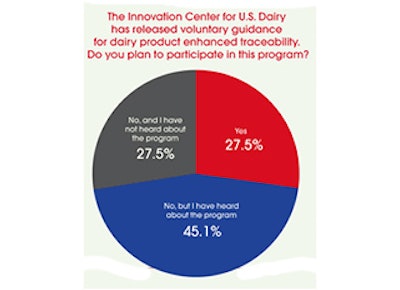
This article originally appeared in the November/December 2013 issue of Food Manufacturing.
The Food Safety Update section of Food Manufacturing is designed to offer our readers insight into the state of food safety concerns across the industry. We received hundreds of responses to this month’s survey on dairy processing.
Dairy processors are faced with unique challenges due to the nature of the fresh product they are handling. The majority of milk-based products are liquid or moist, creating an environment at high risk of microbiological contamination. In addition, the animal origin of dairy products and ingredients further increase the likelihood that such contamination will be introduced into the production process.
Manufacturers in the dairy industry take a variety of measures to ensure the safety of their products. Thirty-four percent of readers said that their facility is a member of the National Conference on Interstate Milk Shipments (NCIMS), and nearly 52 percent reported that their facility participates in Dairy Grade A Voluntary HACCP, a program developed in collaboration with the FDA and the NCIMS. This number is up slightly from September 2012, when 36.4 percent reported involvement in the program.
In addition to NCIMS and the Dairy Grade A Voluntary HACCP program, dairy processors maintain the safety of their products by utilizing a range of methods. According to the chart at right, the majority (62.7 percent) of survey respondents said that they have adopted quality assurance testing. Dairy producers seem to equally favor Pasteurized Milk Ordinance (PMO) Standards and HACCP plans separate from the one recommended by the FDA. Fifty-three percent of readers said that they abide by PMO standards, while 54.9 percent said that they use some type of HACCP plan.
A new voluntary option has emerged this year to help improve food safety in dairy facilities. The Innovation Center for U.S. Dairy has released voluntary guidance for enhanced traceability of dairy products. While the program is still very new, 27.5 percent of readers reported that they already plan to participate in the program, as seen in the chart below. An equal number said that they have yet to hear about the program, while 45.1 percent know of the program but do not plan to participate at this time.
Third-party inspections still play a large role in the dairy industry, as 73.1 percent of respondents indicated that they use third-party auditors to inspect their facility. About half of readers (51.9 percent) reported that their plants are inspected by the FDA, while 34.6 percent said that the USDA inspects their facilities.
Clean-in-place systems are especially crucial in dairy processing environments, and 60 percent of readers said that they use such systems. In fact, 22 percent of those who currently have clean-in-place systems in their plants say they plan to acquire even more.
As the Food Safety Modernization Act (FSMA) continues to be implemented, the dairy industry overall maintains a favorable view of the new regulations. Readers reported that they think new FSMA requirements for dairy facilities are “good on the whole” and that they plan to “fully cooperate with them.” However, respondents also said that the new rules present some challenges. One reader commented, “Overall I am satisfied with the regulatory factors of it all. I just want to be kept up to date,” while another respondent noted that the FSMA is “very comprehensive and challenging to implement.”
In the face of these new regulatory requirements, dairy processors appear ready and willing to take the necessary steps to continue to increase the food safety of their products. The dairy industry will continue to implement technology and other services to help create the safest dairy products possible.



















